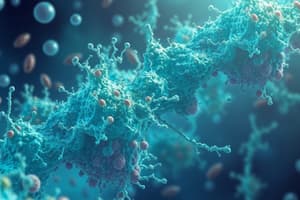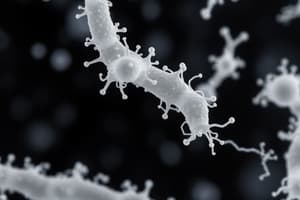Podcast
Questions and Answers
What is the primary benefit of using polymerase chain reaction (PCR)?
What is the primary benefit of using polymerase chain reaction (PCR)?
- It requires extremely low temperatures for reactions.
- It can permanently alter DNA sequences.
- It eliminates the need for a DNA template.
- It allows for rapid synthesis of DNA fragments. (correct)
Which component is essential for stabilizing the reaction components in PCR?
Which component is essential for stabilizing the reaction components in PCR?
- Buffer (correct)
- Nucleotides
- DNA template
- Primers
At which temperature does the denaturation step of PCR occur?
At which temperature does the denaturation step of PCR occur?
- 72ºC
- 94ºC (correct)
- 60ºC
- 50ºC
What role do primers play in the PCR process?
What role do primers play in the PCR process?
What is the purpose of the Taq polymerase in PCR?
What is the purpose of the Taq polymerase in PCR?
How many copies of DNA can be produced after 30 cycles of PCR starting from one DNA molecule?
How many copies of DNA can be produced after 30 cycles of PCR starting from one DNA molecule?
During which PCR step do primers bind to single-stranded DNA?
During which PCR step do primers bind to single-stranded DNA?
What is the unique temperature tolerance characteristic of Taq polymerase?
What is the unique temperature tolerance characteristic of Taq polymerase?
What is the primary purpose of Real-Time PCR?
What is the primary purpose of Real-Time PCR?
What method is primarily used for detecting HIV and monitoring progression of the disease?
What method is primarily used for detecting HIV and monitoring progression of the disease?
Which gene is most commonly sequenced for microbial identification?
Which gene is most commonly sequenced for microbial identification?
What does plasmid fingerprinting specifically assess in microbial strains?
What does plasmid fingerprinting specifically assess in microbial strains?
What is the correct sequence of events in the plasmid fingerprinting process?
What is the correct sequence of events in the plasmid fingerprinting process?
What is the primary purpose of using API test strips in microbiology?
What is the primary purpose of using API test strips in microbiology?
Which method is commonly employed in molecular microbiology for the analysis of genetic material?
Which method is commonly employed in molecular microbiology for the analysis of genetic material?
What does Reverse Transcriptase PCR primarily amplify?
What does Reverse Transcriptase PCR primarily amplify?
In the Kirby–Bauer method, what are the discs containing antibiotics used for?
In the Kirby–Bauer method, what are the discs containing antibiotics used for?
What does the process of plasmid fingerprinting help to identify?
What does the process of plasmid fingerprinting help to identify?
Why is PCR considered effective in detecting pathogens?
Why is PCR considered effective in detecting pathogens?
How do serological tests differ from molecular techniques in microbial identification?
How do serological tests differ from molecular techniques in microbial identification?
What is the significance of using sequence specific primers in PCR?
What is the significance of using sequence specific primers in PCR?
Flashcards
PCR (Polymerase Chain Reaction)
PCR (Polymerase Chain Reaction)
A method to rapidly create many copies of a specific DNA segment.
PCR Components
PCR Components
Water, buffer, DNA template, primers, nucleotides, Mg++ ions, and DNA polymerase are needed to perform PCR.
PCR Denaturation
PCR Denaturation
The step in PCR where heating separates the DNA double helix into two single strands.
PCR Annealing
PCR Annealing
Signup and view all the flashcards
PCR Extension
PCR Extension
Signup and view all the flashcards
Taq Polymerase
Taq Polymerase
Signup and view all the flashcards
PCR Cycle
PCR Cycle
Signup and view all the flashcards
PCR Results Visualization
PCR Results Visualization
Signup and view all the flashcards
Real-Time PCR
Real-Time PCR
Signup and view all the flashcards
Reverse Transcriptase-PCR
Reverse Transcriptase-PCR
Signup and view all the flashcards
DNA Sequencing
DNA Sequencing
Signup and view all the flashcards
Plasmid Fingerprinting
Plasmid Fingerprinting
Signup and view all the flashcards
PCR Product Bands
PCR Product Bands
Signup and view all the flashcards
API Test Strips
API Test Strips
Signup and view all the flashcards
Enzymatic Activity
Enzymatic Activity
Signup and view all the flashcards
Antimicrobial Susceptibility Testing
Antimicrobial Susceptibility Testing
Signup and view all the flashcards
Kirby-Bauer Method
Kirby-Bauer Method
Signup and view all the flashcards
MacFarland Standard
MacFarland Standard
Signup and view all the flashcards
Inhibition Zones
Inhibition Zones
Signup and view all the flashcards
Molecular (Genotyping) Methods
Molecular (Genotyping) Methods
Signup and view all the flashcards
Study Notes
Chapter 5: Diagnostic Microbiology
- The successful identification of microbes depends on proper aseptic techniques, correct specimen collection and handling, and rapid transport to the laboratory.
Microbe Identification
- Accurate microbe identification relies on using proper aseptic techniques, correct specimen collection and handling, and promptly transporting the specimen to the lab.
Identification of Microorganisms
- Microbiologists use three main methods:
- Classic microbiology
- Molecular microbiology (genetic tests)
- Immunological analysis
Where to Start?
- Diagnostic process begins with a patient with suspected infection.
- Two primary routes exist: the immunological route and the microbiological route.
- The microbiological route branches out from various specimens (e.g., blood, urine, mucosal swabs) and various methodologies to reach a definitive diagnosis.
- Conventional microbiology involves culture, enrichment, and isolation
- Molecular microbiology includes methods like nucleic acid hybridization, PCR, and fluorescent antibodies.
- Immunological testing searches for antibodies to identify pathogens.
Classic Microbiology: The 5 Is
- Inoculation: producing a pure culture of microbes.
- Incubation: growing microbes under proper conditions.
- Isolation: Isolating a single, pure culture of microbes; one kind of microbe on a culture medium.
- Inspection: Observation of characteristics (data) of a colony.
- Identification: Using the data to identify the organism to the exact species.
Inoculation
- Introduce bacteria into a growth medium using aseptic technique; preventing contamination.
- Tools: Bunsen burner, platinum loop.
Incubation
- Growing organisms under optimal conditions (temperature, oxygen).
- Tools used to manage oxygen levels include methylene blue indicator strips, GasPak, and anaerobe jars.
Isolation
- Obtaining a pure culture of a specific microbe from a mixed sample.
Identification
- Identifying organisms based on their characteristics.
- Form (circular, irregular, etc.)
- Elevation (raised, flat, etc.)
- Margin (entire, undulate, etc.)
Identification in Selective Media
- Using specific media to identify frequently isolated gram-negative rods.
- Different media show different colony characteristics for various microbes
- Tables provide identification indicators for various species
Confirmation Tests I: Catalase
- Catalase is an enzyme that neutralizes toxic forms of oxygen metabolites (H₂O₂).
- Anaerobes lack this enzyme while aerobes possess the enzyme
- Catalase breaks down hydrogen peroxide (H₂O₂) into oxygen (bubbles) and water.
Confirmation Tests II: Oxidase
- Cytochrome c oxidase is an enzyme used to identify bacteria.
- The presence of cytochrome c oxidase is identified by oxidizing a reagent (such as tetramethyl-p-phenylenediamine) to create a purple color end product.
- Absence of the enzyme maintains the reagent in a reduced colorless form.
Confirmation Tests III: API Systems
- API test strips use dehydrated substrates to detect enzymatic activity associated with carbohydrate fermentation and protein/amino acid catabolism.
- Bacterial suspension is used to rehydrate wells and incubate for results/identification
Antimicrobial Susceptibility Testing
- Antimicrobial drugs are used to treat infectious diseases.
- Testing susceptibility to individual antimicrobials ensures appropriate chemotherapy.
The Standard Procedure: Kirby-Bauer Method
- Step 1: Isolate a colony and dilute it with sterile water to achieve an equivalent density of 1 McFarland.
- Step 2: Dip a swab into the liquid culture.
- Step 3: Streak the swab evenly across the sterile agar plate.
- Step 4: Place discs containing known amounts of different antibiotics onto the plate. After incubation: Observe the inhibition zones.
Molecular Microbiology
- Molecular methods primarily focus on examining the genetic material of microbes.
- Genotype-based techniques are increasing in use for their speed and accuracy.
Molecular (Genotyping) Methods
- Examining the genetic material is the principle of these methods.
- Specific techniques are becoming central for accurate and quick identification.
Genotypic Methods
- PCR, real-time PCR, reverse transcriptase PCR, rRNA analysis, and plasmid fingerprinting are genotypic methods for microbe identification.
Polymerase Chain Reaction (PCR)
- PCR is a technique widely used for microbe identification.
- PCR uses sequence-specific primers to amplify DNA/RNA from pathogens.
- PCR enables identification of organisms even when present at extremely low numbers in samples, and is used for non-culturable organisms
PCR Reaction Components
- Water, buffer, DNA template, primers, nucleotides, Mg++ ions, and DNA polymerase are essential components of a PCR reaction.
PCR Overview
- Cycles of denaturation, annealing, and extension, repeat to vastly amplify original DNA in a sample.
- PCR products resulting from repeated cycles of amplification can be used to identify a sample.
Taq Polymerase
- Taq polymerase is a heat-stable DNA polymerase derived from the bacterium Thermus aquaticus.
- Taq polymerase withstands high temperatures essential in PCR procedures without losing its functionality.
PCR: Visualizing Results
- After the PCR cycling, sample tubes are taken out of the machine and loaded into an agarose gel.
- The DNA contained in the tubes is separated by size via an electric field on the gel, with visualization using staining.
Real-Time PCR
- Real-time PCR methods utilize fluorescent primers.
- PCR machine monitoring allows researchers to view the amplification plot continuously and track the PCR cycle.
- Benefits include obtaining results immediately.
Reverse Transcriptase-PCR
- Methods that involve generating cDNA from RNA; this allows for further study of the RNA material.
- Often used to detect and monitor the course of HIV, due to this virus existing in a RNA form.
- An essential method to isolate RNA material for analysis.
DNA Sequencing
- Small amounts of DNA are sufficient for microbial identification using sequencing.
- The 16S rRNA gene sequence is a common marker for identifying microbes.
- Using DNA sequencing techniques determine the sequence of the 16S rRNA gene.
Plasmid Fingerprinting
- Plasmid fingerprinting is a technique used to identify microbial species or similar strains— strains often harbor the same number of plasmids with the exact same molecular weight.
- Fingerprinting of plasmids in various strains (e.g., E. coli, Salmonella, Campylobacter, and Pseudomonas) reveals that this method is better than alternatives such as antibiotic resistance patterns or immunological tests.
Immunological route
- Involves the interaction of a microbial antigen with an antibody.
- Methods detect microbial antigens or antibodies using specific tests.
Immunological methods (II)
- The analysis includes antibody-antigen interactions in a lab setting; this is known as serology.
- Sensitivity and specificity are important characteristics of serological tests for reliable results.
- Sensitivity means the ability to detect small quantities of antigens (Ag)/antibodies (Ab). Specificity means the technique is capable of recognizing one particular antigen/antibody in the presence of several others.
False Negatives/Positives
- High sensitivity avoids false negatives; a test can still produce a correct result even if some antigen/antibody is missed.
- High specificity avoids false positives; the test is very particular about an antigen/antibody.
Immunological tests
- Precipitation, Agglutination, Fluorescent, ELISA, Immunoexpert are examples of immunological tests.
Precipitation Reactions
- Precipitation involves the interaction between a soluble antigen (Ag) and antibody to produce an insoluble complex, causing clumping/precipitation
- Used for identifying streptococcal antigens.
- Reactions occur optimally with precise amounts of Ag and Ab.
Agglutination Reactions
- Agglutination is observed as visible clumping of an antigen (Ag) when mixed with its corresponding specific antibody (Ab); useful for identifying blood types and pathogens.
- Standardized tests for various blood groups, pathogens, or components are available to help aid in identification and diagnosis.
Direct Agglutination
- A soluble antibody (Ab) directly causes clumping of a cell by binding to a specific cell-surface antigen (Ag).
- Helpful in identifying blood types and pathogens.
Indirect or passive Agglutination
- A soluble antigen (Ag) is chemically attached to an inert particle (e.g., latex bead).
- The combined mixture of Ag and particle will then allow for antibody detection.
- Helps detect various microorganisms.
Fluorescent Antibodies
- Fluorescent dyes are used to label antibodies for direct or indirect detection of microbes in tissues or fluid for diagnosis/treatment.
ELISA (Enzyme-Linked Immunosorbent Assay)
- A plate-based technique using antibodies to detect antigens.
- ELISA is a helpful technique for identifying many pathogens (e.g., S. aureus, E. coli, Salmonella).
ImmunoXpert™
- ImmunoXpert™ is a sophisticated diagnostic test that distinguishes between viral and bacterial infections.
- It analyzes a patient's immune response by evaluating multiple proteins in the blood.
- It can aid doctors in quicker diagnosis.
Studying That Suits You
Use AI to generate personalized quizzes and flashcards to suit your learning preferences.
Related Documents
Description
This quiz covers the key concepts of Chapter 5 in Diagnostic Microbiology, focusing on the methods of microbe identification and the importance of specimen collection and handling. You'll explore the different routes used in the diagnostic process, including classic, molecular, and immunological microbiology. Test your understanding of these essential microbiological techniques and their applications in diagnosing infections.




